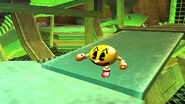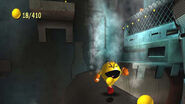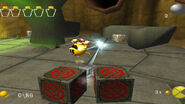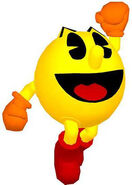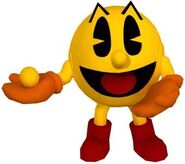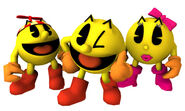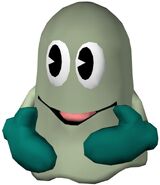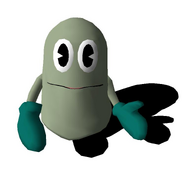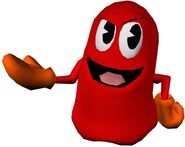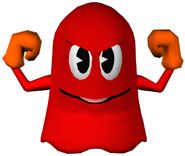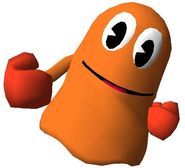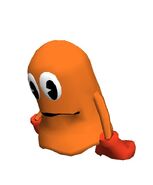Pac-Man World 3 is a game in the Pac-Man series developed by Blitz Games and published by Namco Hometek (co-published with Electronic Arts in Europe[1]) in 2005 to celebrate Pac-Man's 25th anniversary.
It is the third game in the Pac-Man World series (serving as the sequel to Pac-Man World 2), and was developed by Blitz Games; the first Pac-Man World game to not be developed by Namco internally. The Nintendo DS version was developed by Human Soft.
Story[]
Note: some parts of this section may be considered spoilers.
On a peaceful day in the Pac-Village, Ms. Pac-Man and Junior surprise Pac-Man as he arrives home on his 25th birthday. After happily arriving home, Pac-Man's Pac-Sense begins to tingle, and begins teleporting across the Pac-Village in random locations. Orson, one of Pac-Man's arch-enemies, is seen trying to get a Pac-Man arcade machine-style teleporter to work, who is revealed to be behind Pac-Man's teleportation. Pac-Man continues to teleport, eventually appearing flying towards his birthday cake before vanishing to places unknown, confusing Ms. Pac-Man and Junior of his whereabouts.
Pac-Man is teleported to the Spectral Realm's Bot Boneyard, and receives transmissions from his Pactrometer. Orson reveals himself to Pac-Man, who summoned Pac-Man to the Spectral Realm in order to stop Erwin, a mad scientist and Orson's former colleague from syphoning the Spectral Realm's energy which poses as a threat to both the Spectral Realm and Pac-Land. Upon reaching his base in the Banni Wasteland, Orson suggests Pac-Man to find Blinky, Pinky, Inky and Clyde across the Spectral Realm and stop his Spectral Syphons, also allowing Pac-Man to use a newly-built Toc-Man model.
Pac-Man heads to the Spectral Realm and begins to destroy the Spectral Syphons being used by Erwin, which were beginning to rip apart the fabric of space and time, in the event of a Spectral Paradox. Along the way he rescues Pinky and Blinky from their imprisonment, and defeats the Spectral Fiend, one of Erwin's henchmen. As well
Heading back to the Realm for the final time, the area is in the worst state possible - Erwin's siphoning has completely destroyed it. Making his way through the now decrepit Realm, Pac-Man succeeds in traversing through the sinking landscape. He makes it to the Shadow Temple, where Erwin is hiding out as a last resort with a giant syphon. Pac-Man challenges Erwin, who fights in his Teradecahydratron holding Inky and Clyde captive.
Pac-Man defeats Erwin in his Teradecahydratron and frees Inky and Clyde in the process of destroying the Teradecahydratron. Erwin flees from the scene to his last Syphon, with Pac-Man following pursuit. After being cornered by Pac-Man, Erwin starts to complain about him destroying his plans. While Erwin continues to argue to Pac-Man, the syphon's energy begins slowly sucking in Erwin, who notices after Pac-Man tells him to "keep his feet on the ground". Erwin is sucked into the syphon as it explodes, ultimately ending his evil regime.
In the Pac-Village, Ms. Pac-Man continues to wonder about her husband's whereabouts while Junior reads a book. Pac-Man soon appears above his house and plummets down to the ground, with Ms. Pac-Man just barely saving Pac-Man's birthday cake from being splattered, though not long before Blinky teleports directly under the birthday cake. Pinky, Inky and Clyde soon teleport to Pac-Man's house following Blinky, where Pac-Man and Pinky explain Erwin's attempted conquest of the Spectral Realm. Blinky then tells Ms. Pac-Man that they want to stay with Pac-Man while Orson fixes the Spectral Realm. Asking what's for dessert, Ms. Pac-Man declares Blinky and the ghosts will be dessert, prompting the ghosts to run away. Junior tosses a Power Pellet that Pac-Man eats, and returns to his natural habit of chasing the ghosts.
Gameplay[]

E3 screenshot of Pac-Man World 3
Similar to its predecessors (Pac-Man World 1 and 2), Pac-Man World 3 is a 3D platformer that places Pac-Man in a 3D platforming environment, where he ventures into the Ghosts' Spectral Realm to stop Erwin. Pac-Man travels across various areas and solves puzzles and platforming. The main goal of each level is to complete the indicated objective for each area (such as reaching the end of an area, defeating a horde of enemies or interacting with the level terrain). In some areas, Pac-Man can return to previous locations to complete missed objectives. Pac-Man can withstand up to four hits from enemies or hazardous objects/terrain. If he is hit a fourth time, he loses a life and must restart from the last checkpoint. If all lives are lost, the game is over and the player must restart from the last point saved. The player can save their game by reaching save point pads spread throughout the game's levels or by completing a level, allowing them to continue at a later time. Upon completing a level for the first time, the player can return to said level via the Level Select option in the title screen menu.
Unlike the previous installments, Pac-Man World 3 features a greater emphasis on fighting and melee-style combat gameplay. Across many of the levels, Pac-Man will encounter hordes of enemies he must defeat. Pac-Man can now perform melee punches and can land combo hits by performing multiple hits repeatedly. Some returning moves from previous games include the Rev-Roll (which can break creates, defeat enemies and activate Rev-Roll pads) and the Butt Bounce (which can only be done three times consecutively now, though the third bounce creates a shockwave), which helps Pac-Man progress through different kinds of terrain. Pac-Man can also find a variety of new power-ups to assist him during combat, alongside returning power-ups such as the Power Pellet, which are used to eat Spectral Monsters. Pac-Man also can also Wall Jump on certain walls, as well as grabbing onto fences and ledges; also being able to move on them.
Across the levels, Pac-Man can also find a variety of collectable items, such as Pac-Dots, Fruit and Silver Pac-Man statues. Pac-Dots, Fruits and silver Pac-Man statues serve as extra collectibles, and grant extra points. Pac-Man gains an extra life for every 10,000 points collected, or finding Pac-Man symbol icons throughout the levels. Pac-Man can also recover hit points by collecting health wedges, though this time he can no longer collect them if he has full health. There are also collectable cards that can be found within the levels, with two additional cards earned for collecting all fruit and silver statues within a level respectively. These collectable cards can be viewed in the Museum.
Across the game, Pac-Man will go into Maze Mode, either by level progression or by finding the hidden Galaxian Flagships throughout the levels. While the Galaxian mazes are optional, there are certain occasions where Pac-Man must interact with Pac-Man syphon terminal cabinets within the levels in order to progress through the game.
Maze Mode[]
Pac-Man enters maze mode either through accessing Pac-Man syphon terminal cabinet present throughout the levels, or by collecting hidden Galaxian Flagships within the levels. While Galaxian mazes are optional to play, the Pac-Man cabinets within the levels are required to play through in order to progress through the story. Points earned within the Maze mode are not transferred to the main game.
Maze Mode plays similar to the original Pac-Man, where the main goal is to eat all the Pac-Dots in the maze while avoiding the four ghosts. Pac-Man has 3 lives to complete the maze, separated from his life count in the regular world. If Pac-Man completes the maze, he will be awarded an extra life in the regular world. If Pac-Man loses all his lives, he will simply be booted back out of the maze. The ghosts do not pursue Pac-Man as often, but move at Pac-Man's speed. Occasionally, a robot will spawn within the maze and will regenerate up to 15-20 Pac-Dots in a set location within the maze. Pac-Man can destroy the robot by simply touching it.
Across the mazes, Pac-Man can also find various power-ups spawning within the mazes:
- Power Pellets: Pac-Man gains the temporary ability to eat the ghosts. For each consecutive ghost eaten, Pac-Man will gain 200, 400, 800 and 1,600 points.
- Fruit: The Fruit that periodically spawns beneath the Ghost House can be eaten for bonus points.
- Dash Arrows: If Pac-Man runs across them in the indicated direction, he will dash for a few seconds, stunning any ghosts if they are touched by the dashing Pac-Man.
- Capsules: Capsules will spawn at Pac-Man's starting point occasionally. The effects of each capsule depend on the color:
- Orange Capsule: Pac-Man's speed is temporarily increased.
- Blue Capsule: A mirror clone of Pac-Man appears in the maze, which reflects Pac-Man's movement within the maze from the opposite direction. The mirror clone can eat just like Pac-Man.
- Red Capsule: All ghosts are frozen in place, but they can still hurt Pac-Man if they aren't under Power Pellet effects in this state.
- Green Capsule: All ghosts are sucked into a vortex within the Ghost House and are trapped in the vortex for 5 seconds.
Playable characters[]
In this game, Pac-Man receives assisting hands from the Ghosts, Blinky (erroneously referred to as Clyde in-game), Pinky and Orson. Orson gives Pac-Man notable advice throughout his journey and lets him use his upgraded Toc-Man for combat. Among the assisting ghosts are Blinky and Pinky, whom are summoned into the field at a Ghost Rev-Roll Pad. Pinky can turn up to 3 invisible platforms only solid to her into solid platforms for Pac-Man to cross, though she needs to find Spectral Fountain energy orbs to solidify each platform. Blinky uses his Sonic Boo to scare off enemies, and can charge up a Super Scare which can destroy certain terrain.
- Pac-Man - The main playable character of the game. Pac-Man uses his attacks to progress through the game.
- Pinky - Pinky can solidify invisible platforms into visible for Pac-Man to jump on. However, she can only maintain up to 3 solidified platforms using Spectral Fountain energy orbs, which are encountered throughout the levels.
- Blinky - Blinky attacks enemies using his Sonic Boo, allowing him to scare Spectral Monsters. He can also use the Super Scare to destroy certain terrain.
- Toc-Man - Pac-Man and Blinky occasionally use Orson's rebuilt Toc-Man to combat hordes of enemies in certain levels. Pac-Man can use Toc-Man's arms to attack enemies, while Blinky can use Toc-Man's laser. Pac-Man can also spin around Toc-Man's arms to rapidly defeat enemies, though this will overheat and stun Toc-Man for a while if the heat meter reaches its maximum limit.
Fruits[]
- Cherry - 100 points
- Strawberry - 300 points
- Orange - 500 points
- Apple - 700 points
- Watermelon - 1000 points
Power-Ups[]
In addition to the regular Power Pellets found throughout the levels, there are several new Power Pellet variants that give Pac-Man different powers to fight enemy hoards. All power-ups last 15 seconds.
- Power Pellet - Used to eat the blue Spectral Monsters.
- Ribbon Loop Power Pellet - Tan-colored pellet. Pac-Man gains a tan aura, and a trail of tan follows him. If he wraps around an enemy, it will close in on them and kill them.
- Super Stomp Power Pellet - Green-colored pellet. Pac-Man gains a green aura, and if he does a Butt-Bounce, a powerful green shockwave spreads out around him, initiating a ripple in the ground.
- Electro-Shock Power Pellet - Blue-colored pellet. Pac-Man gains a blue aura, and by pressing and holding the "Punch" button, Pac-Man can shoot electricity out of his hands. The Electro-Shock Power Pellet is also used to charge up a Power Generator.
- Chrome Power Pellet - Silver-colored pellet. Pac-Man gains a metal sheen and briefly becomes invincible both against enemies and dangerous obstacles that may harm him. When he does a Butt-Bounce, his metal body can destroy enemies much faster than normal.
- Pac-Dot Chain - Machines activated by crystals. They contain one large, red Pac-Dot to start with, and a long trail of Pac-Dots after that. Once Pac-Man eats it, he travels the length of the Pac-Dots. The player can regenerate Pac-Dot Chains any time by returning to the machine, though they will not grant extra Pac-Dots after passing through them once.
Levels[]
- Bot Boneyard
- Banni Wastelands
- Spectral Cliffs
- Gogekka Central
- Spectral Vale
- Zephyr Heights
- Ancient Catacombs
- Gogekka Heights
- Banni Canyon
- Toc-Man Battle
- Cragstone Bridge
- Erwin's Fortress
- Dungen Gunden
- Spectral Zenith
- Shadow Temple
Museum[]
In the Extras section of the Main Menu, the player can visit the Museum which contains selections of extra content:
- Pac-Man arcade cabinet: This allows the player to play the original Pac-Man. The version of Pac-Man featured in Pac-Man World 3 is unique compared to other versions, such as:
- The text font is smaller than the original.
- Pinky and Inky move sideways in the Ghost House instead of up and down.
- Pac-Man does not slow down when eating Pac-Dots.
- Pac-Man does not gain an extra life at 10,000 points.
- The Bonus Fruit appears and disappears with a growing/shrinking animation.
- The Orange is miscolored red.
- Characters in cutscenes move slower than usual.
- The sound effects appear to be based on the common Namco Museum port (used in several releases during this era), despite that the code itself is not.
- Timeline board: The player can view a history of Pac-Man games released for arcades and consoles released between 1980 and 2005.
- Collectable card display: The player can view the cards they have collected in Pac-Man World 3 (these are found within the levels). The cards display artwork of the game's characters, scenery and concept art.
- Video display: The player can watch a special interview video featuring Toru Iwatani, talking about Pac-Man and his history.
- TV: The player can watch a trailer for Pac-Man World Rally. The TV is absent in the Nintendo GameCube version.
History and Development[]
Pac-Man World 3 had a very rough development cycle, going through many forms before its eventual release. The project seemingly started life as Pac-Man Adventures, a scrapped game which originated around 2003. It was being worked on by animator Don Bluth (of An American Tail and Dragon's Lair fame), who has since published many storyboards he created for it. Many of the concepts seen in the Pac-Man Adventures storyboards were later reused in World 3, to varying degrees.
After Pac-Man Adventures' cancellation, Namco Hometek hired British development company Blitz Games to develop Pac-Man World 3. As the game was being developed, however, Namco of Japan had begun their plan to merge with Bandai, forming Bandai Namco Holdings. The new ownership change caused Namco to cancel practically every Pac-Man game planned for release in 2005/06, including Pac-Man World 3. Blitz Games begged Namco to let them continue production of the game; Namco eventually agreed to this, but they would not provide any additional funding for it, and demanded it to be released by the end of 2005.[2]
The game officially launched in November of 2005, in an arguably incomplete state. Many planned features were removed entirely due to the tight release deadline. Some notable scrapped elements include:
- The ability to collect and hold Power Pellets, which could be used at any time.
- "Power Smoothies", formed from collecting Fruit throughout the level; their planned function is unknown.
- A small shop where Pac-Man could buy items. It is still present in the Namco Transmission 3.1 and 3.2 demo disks, in which it says "Shop Opening Q4 2005".
- Various levels and environments. A handful of them were still present in the Nintendo DS version, presumably due to it being outsourced to Human Soft.
Home Ports[]
- Nintendo GameCube
- PlayStation 2
- The PlayStation 2 version features graphical distortion effects which are absent in other versions
- Xbox
- PlayStation Portable
- Port of the Console/Windows versions.
- Adds a Multiplayer mode.
- Lacks save points, so the game will only save when a level is completed.
- Plays at a slightly lower framerate.
- Nintendo DS
- Features several additional levels compared to other versions, which are believed to have been removed from other releases due to development time constraints.
- Only one Maze is featured (inside the "Extras" menu), and all video cutscenes are downgraded to static images.
- In late 2012, the game was re-released as a "Dual Pack" with Namco Museum DS.
- Microsoft Windows
- DRM used for this version depends in North America and Europe.
- North American versions use StarForce, meaning the game can't officially be played on Windows Vista or higher.
- European versions instead use SecuROM, allowing the game to be played on newer Windows systems.
- DRM used for this version depends in North America and Europe.
Metacritic gave the game a score of 44% for the DS, 61% for the PSP, 63% for the PS2, 65% for the Xbox, 66% for the Gamecube, and 74% for the PC. The DS and PC versions might be considered the worst and best versions respectively.
Cast[]
- Martin T. Sherman as Pac-Man and Clyde
- Stuart Milligan as Orson and Inky
- Eric Meyers as Erwin
- Mindy Lee Raskin as Pinky
- Regina Reagan as Ms. Pac-Man
- John Guerrasio as Blinky, Spectral Fiend, Construction Worker and Archaeologist
- Garrick Hagon as The Ancient Hero
Trivia[]
- The game was originally going to be subtitled "The Elixir of Life", but was shortened to just Pac-Man World 3 upon its release.[3]
- This game marks the first time Pac-Man has voiced dialogue within a video game. Previously, he had only made noises or screams, or had text appear on-screen. Pac-Man's voice is played by Martin T. Sherman, known for voicing characters such as Thomas the Tank Engine in other media.
- Unlike the previous two Pac-Man World games, Pac-Man World 3 was not released in Japan, likely either due to the formation of Bandai Namco Games or the heavy language translation process it would require.
- This is the first Pac-Man video game where the ghosts (Blinky, Pinky, Inky, Clyde and Orson) make an alliance with Pac-Man and are not portrayed as antagonists. The antagonist roles are filled in by Erwin, the Spectral Fiend, Spectral Monsters and Spectral Ghosts.
- Other notable instances of Pac-Man forming alliances with the original Ghost Gang includes Pac-Man Monsters and the Pac-Man & the Ghostly Adventures series.
- The Pac-Village design seen in the opening resembles the Pac-Village in Pac-Man World 2.
- The Maze Mode in Pac-Man World 3 features power-ups that function very similarly to the power-ups in Pac-Man Arrangement (1996).
- This game makes heavy usage of the Clyde and Blinky error, more so than any other entry in the series. The error is very noticeable in-game, and has led to lots of confusion.
- According to Retro Gamer Magazine Issue 207, a Game Boy Advance version of Pac-Man World 3 was planned, but was ultimately canceled. Very little information is known about it, but judging by Pac-Man World 2's GBA version, it likely would have greatly differed from the original.
- Additionally, Blitz Games has stated they didn't know that a Game Boy Advance release was ever planned. This may suggest it did not get very far into development, if at all.
- As Pac-Man's teleporting all over the place until he's in the air one last time, before he flies towards the cake, he says "Aah, well. Least this birthday's still better than my twentieth!" This is a reference to him mentioning his 20th Anniversary/20th Birthday in Pac-Man World.
- The Museum features posters and banners originating from different Pac-Man games and ports:
- The Bally Midway marquees and promotional flyers of Pac-Man can be seen in the museum, though all mentions and marks of Bally Midway are digitally erased.
- A cover resembling the Neo Geo Pocket Color box art of Pac-Man can be seen (specifically based on the U.K. version), though the artwork is replaced with a 3D Pac-Man render from Pac-Man World 3. Most mentions of the Neo Geo Pocket Color are also erased; though strangely, the bottom line reading "Neogeo Pocket Software Cartridge" in plain text remains visible.
- The classic winking pose of Pac-Man, using artwork from the first Pac-Man World game.
Gallery[]
Screenshots[]
Box Art[]
Artwork[]
References[]
- ↑ https://www.eurogamer.net/news191005pacmanworld3
- ↑ "Retro Gamer" issue #163, pages 74-75
- ↑ https://trademarks.justia.com/783/89/pac-man-world-3-the-elixir-of-life-78389851.html

